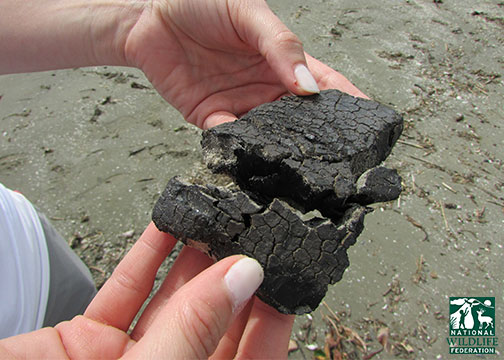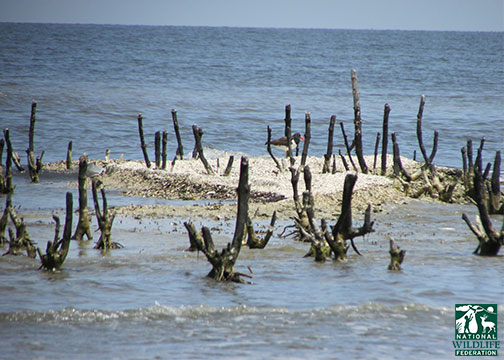We have much more to do and your continued support is needed now more than ever.
No Joke – Oil Still Contaminating Louisiana Coast
Yesterday, NWF and our coalition partners traveled out to Louisiana’s Barataria Bay to search for continued impacts from 2010’s Gulf oil disaster.
We didn’t have to look very hard.
Our first stop was East Grand Terre, a small barrier island where just two weeks ago, we discovered a BP work crew cleaning up a 25,000-pound tar mat, which was later confirmed through an oil identification process to be BP oil. The big tar mat may be gone, but all along the island, we found evidence of oil – tar mats, tar balls and oiled residue. The tar balls were hard, thick and difficult to break in one’s hands. The insides were rubbery and sticky, and they smelled like asphalt or plastic. These oily materials are not just on the shore’s surface – they’re also buried in the sand and sediment. Wave action and storm events continue to deposit them on barrier islands, beaches and marshes that provide habitat for animals like brown pelicans, American oystercatchers, crabs, sea turtles – resulting in a chronic “re-oiling” of these areas.

Next, we traveled to Cat Island, which has practically disappeared in the five years since the oil spill began. Once a thriving rookery covered in mangroves and thousands of birds, Cat Island received heavy oil in 2010, which suffocated the vegetation and caused rapid erosion of the island. Yesterday, a lone American oystercatcher patrolled the island. The mangroves are gone.
The island’s size has drastically decreased. There is no plant life on the island – only the remnants of mangroves which are now dead, sticking up out of the gray sand like bones. Cat Island, formerly a lush habitat for wildlife, is a skeleton.


To truly put the Gulf on the road to recovery, BP must accept responsibility for its reckless behavior. Five years later, the Gulf cannot wait any longer.
![]() Tell BP to quit stalling, and accept responsibility for its actions by paying its Clean Water Act fines!
Tell BP to quit stalling, and accept responsibility for its actions by paying its Clean Water Act fines!
![]() We’re still on the ground in Louisiana and across the Gulf working to make sure that BP is held accountable and that the Gulf is restored for dolphins and other wildlife.
We’re still on the ground in Louisiana and across the Gulf working to make sure that BP is held accountable and that the Gulf is restored for dolphins and other wildlife.
For more on the wide-ranging ecosystem impacts from the spill, check out the new infographic from the Restore the Mississippi River Delta Coalition.





















